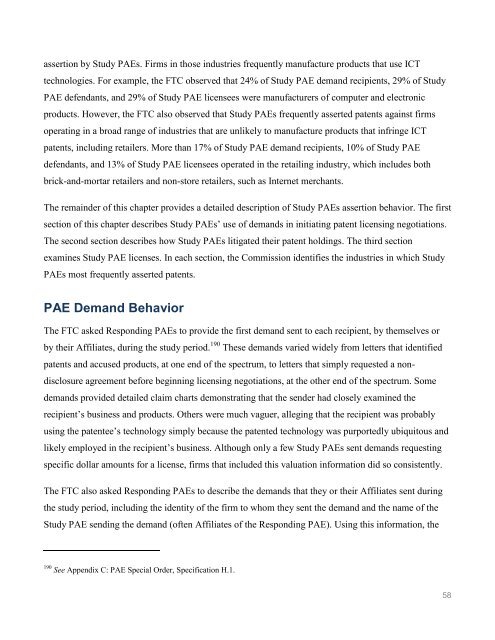You also want an ePaper? Increase the reach of your titles
YUMPU automatically turns print PDFs into web optimized ePapers that Google loves.
assertion by Study PAEs. Firms in those industries frequently manufacture products that use ICT<br />
technologies. For example, the FTC observed that 24% of Study PAE demand recipients, 29% of Study<br />
PAE defendants, and 29% of Study PAE licensees were manufacturers of computer and electronic<br />
products. However, the FTC also observed that Study PAEs frequently asserted patents against firms<br />
operating in a broad range of industries that are unlikely to manufacture products that infringe ICT<br />
patents, including retailers. More than 17% of Study PAE demand recipients, 10% of Study PAE<br />
defendants, and 13% of Study PAE licensees operated in the retailing industry, which includes both<br />
brick-and-mortar retailers and non-store retailers, such as Internet merchants.<br />
The remainder of this chapter provides a detailed description of Study PAEs assertion behavior. The first<br />
section of this chapter describes Study PAEs’ use of demands in initiating patent licensing negotiations.<br />
The second section describes how Study PAEs litigated their patent holdings. The third section<br />
examines Study PAE licenses. In each section, the Commission identifies the industries in which Study<br />
PAEs most frequently asserted patents.<br />
PAE Demand Behavior<br />
The FTC asked Responding PAEs to provide the first demand sent to each recipient, by themselves or<br />
by their Affiliates, during the study period. 190 These demands varied widely from letters that identified<br />
patents and accused products, at one end of the spectrum, to letters that simply requested a nondisclosure<br />
agreement before beginning licensing negotiations, at the other end of the spectrum. Some<br />
demands provided detailed claim charts demonstrating that the sender had closely examined the<br />
recipient’s business and products. Others were much vaguer, alleging that the recipient was probably<br />
using the patentee’s technology simply because the patented technology was purportedly ubiquitous and<br />
likely employed in the recipient’s business. Although only a few Study PAEs sent demands requesting<br />
specific dollar amounts for a license, firms that included this valuation information did so consistently.<br />
The FTC also asked Responding PAEs to describe the demands that they or their Affiliates sent during<br />
the study period, including the identity of the firm to whom they sent the demand and the name of the<br />
Study PAE sending the demand (often Affiliates of the Responding PAE). Using this information, the<br />
190<br />
See Appendix C: PAE Special Order, Specification H.1.<br />
58


